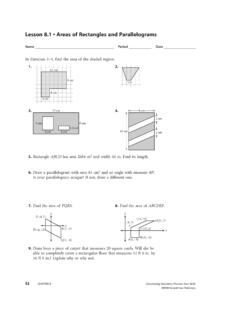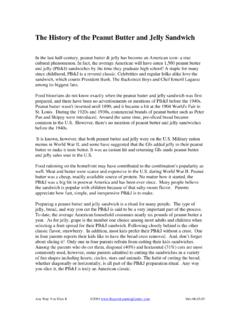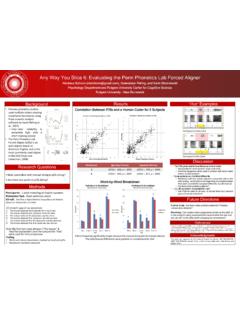Transcription of Any way you slice it - Advanced Optical Microscopy ...
1 1 any way you slice it :James Jonkman comparison of confocal Microscopy techniquesAny way you slice it:A comparison of confocal Microscopy techniquesOptical Microscopy Users Group (O-MUG)2 Confocal Fluorescence MicroscopyWidefieldConfocalA confocal microscope allows you to do Optical sectioning in thick types of confocalsLaser-scanning confocal (including resonant scanning)Spinning-disk confocalGrid-based Optical sectioning, or structured illumination 3 Optical sectioning performance depends on the thickness of the specimenThin (5um)Intermediate (15um)Thick (35 50um)Molecular Probes Slide #1 Cultured BPAE cells, fixedMolecular Probes Slide #3 Fixed kidney slice3D Culture of mammary epithelial cellsLaser-Scanning Confocal4 The laser-scanning confocal principleObjective LensLaserSpecimenBeamsplitterExcitationE missionPinholeDetectorPinhole LensThe laser-scanning confocal principleScanning mirrors deflect the beam laterally (x-y directions)Stage moves specimen through the focus axially (z-direction)
2 XyzDifferent fluorophores may be imaged simultaneously or sequentially5 Laser scanning confocal performance thin sampleWidefieldLaser scanning confocalLaser scanning confocal intermediate sampleWidefieldLaser scanning Confocal6 Laser scanning confocal performance thick sampleWidefieldLaser scanning confocalLaser scanning confocal performance thick sample7 Laser-scanning confocals allow you to choose how many pixels you use1024 x 1024128 x 128 Laser scanning confocal 200xyrnm (GFP)(63x, oil)Rayleigh Criterion (resolution rule of thumb)You need at least twice as many pixels as your smallest resolution nm / m / pixelNyquist Theorem(sampling suggestion)
3 8 Choose your field of view, optimize the samplingSingle nucleus, 63 x 30um512 x 256 pixelsEntire structure 20 x 530um2048 x 2048 pixelsPixelation9 Advantages/disadvantages of confocal laser-scanning fluorescence microscopyAdvantagesDisadvantagesBest general-purpose confocal **Can be slowBest technique for fixed samples, particularly thicker tissuesPhotobleaching can be an issue, particularly with z-stacksFlexible can control scan area, # pixels, pinhole size, laser powerPhototoxicity can be a problem for live-cell imaging**Resonant scanning confocals speed things up considerably, but sacrifice flexibility Resonant-Scanning Confocal10 How slow is the laser-scanning confocal?
4 / 1 1,000,000 / 1 But it can add up to several minutes pretty easily: 4 megapixel image (2048x2048) Sequential imaging of 3 colours Stack of 15 slices(minimum)(1024 x 1024)(minimum)3 minutes / stack!How slow is the laser-scanning confocal? / 250,000 / 512 x 512 image Simultaneous imaging of 3 colours Stack of 15 slices(minimum)(512 x 512)(minimum)30 images/secondor2 stacks / second!11 Zebrafish, 30fpsZebrafish 3D: 8 slice ,16 z-stacks / sec12 Spinning-disk ConfocalSpinning-disk Confocal: The Nipkow disk13 Yokogawa spinning-disk confocal microscopeYokogawa CSU10 Two disks; one with about 20,000 microlenses, the other with pinholes arranged in the same pattern.
5 The disks are rotated together at 1800 rpm so that the light beams raster-scan the specimen. The pinhole pattern is designed to capture 12 frames per rotation or 360 frames per second Time-lapse imaging on the Yokogawa spinning-disk confocalGFP-Tubulin micro-injected into smooth muscle cells; imaged on Yokogawa spinning-disk confocalN-cadherin-GFP stably expressed in smooth muscle cells14 Spinning disk confocal performance intermediate sampleWidefieldSpinning diskSpinning-disk confocal performance thick sampleWidefieldSpinning-diskCompromise #1: For thicker samples (say, > 10um), fluorescence is scattered into the wrong pinhole, reducing the Optical sectioning performance15 Spinning-disk confocal performance thin sampleWidefieldSpinning-diskSpinning-dis k confocals are usually based on EMCCD cameras, with 512 x 512 pixelsCompromise #2.
6 With a camera, you have pixilation and/or a smaller Field of viewHuge pixels make these very sensitive16 Spinning-disk confocals may have pixilationSpinning-disk confocals may have pixilationrawsmooth zoom60 objectiveOptimum pixel size: 100nmActual pixel size: 170nm17 Spinning-disk confocals may have smaller fields-of-viewSpinning-disks are designed for 60x or 100x magnificationsCompromise #3: The pinholes are sized for 100x oil objectives. At 10x, the spinning disk images are indistinguishable from widefield images18 Spinning-disks excel at live-cell imagingAdvantages/disadvantages of spinning-disk confocalAdvantagesDisadvantagesFast confocal imaging for capturing dynamics**Generally not suitable for fixed cells or tissuesLess phototoxicity for live-cell imagingLower resolution and/or smaller field-of-view ( - megapixel camera)Isn t very confocal for thickerspecimens, nor for 20x or lower mag**Some newer spinning disk confocals overcome some of these limitations with multiple cameras and multiple pinhole disks.
7 19 Grid-based Optical sectioning (Apotome)Zeiss ApotomeQuorum Angstrom(Qioptiq Imaging Optigrid)Grid-based Optical sectioning(Structured Illumination)20 Grid-based Optical sectioning(Structured Illumination)Apotome performance thin sampleWidefieldApotome21 Apotome performance intermediate sampleWidefieldApotomeApotome performance thick sampleWidefieldApotome22 For thicker samples (>20um?), grid based Optical sectioning suffers from lack of contrast in the grid patternLike other mathematical techniques in Microscopy (such as deconvolution), grid based Optical sectioning may generate zoomed23 Advantages/disadvantages ofGrid based Optical SectioningAdvantagesDisadvantagesInexpen sive (often dubbed the poor man s confocal !)
8 **Doesn t perform well on thicker specimens (> ~20um?)Cheaper to maintain (no lasers) Plagued by artifacts**Works quite well on a macroscope (Zeiss Axiozoom) with cleared tissues. Two-Photon Microscopy24 Two-Photon microscopyTwo-photon excitationObjective LensLaserSpecimenBeamsplitterObjective LensPulsedLaserSpecimenBeamsplitterConfo calTwo-photon25 Objective LensSpecimenBeamsplitterPinholeDetectorP inhole LensObjective LensSpecimenBeamsplitterLarge-area detectorConfocalTwo-photonLaserPulsedLas erTwo-photon emissionTwo-photon has an advantage over confocal for imaging deep into thicker specimensReason #1: Excitation is confined to the focal plane.
9 Less photobleachingthroughout the volume. Scattered light can contribute to fluorescence signal (if you use good non-descanned Photon26 Two-photon has an advantage over confocal for imaging deep into thicker specimensReason #2: Infrared excitation penetrates deeper into biological of Two-Photon over single-photon (confocal) fluorescence microscopyAdvantagesDisadvantagesLesspho tobleaching and phototoxicity outside of the focal planeMorephotobleaching and phototoxicity inside the focal planeAble to image deeper into thick samplesWorse resolutionAbsorption spectra are broader, so simultaneous excitation of multiple fluorophores is possibleAbsorption spectra are broader, so selective excitation becomes difficultAny way you slice it:James Jonkman comparison of confocal Microscopy techniques)











